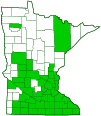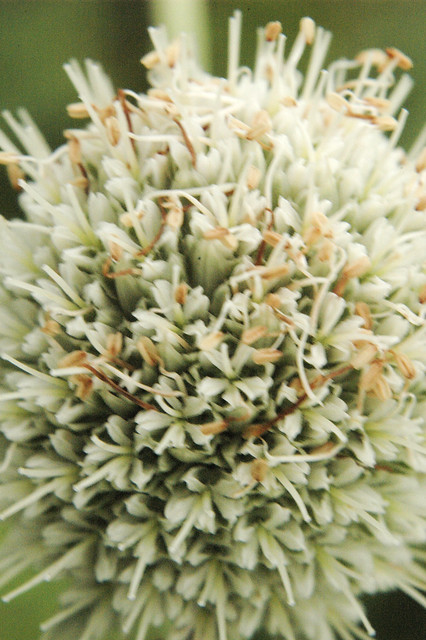rattlesnake master
(Eryngium yuccifolium var. yuccifolium)
Conservation • Wetland • Description • Habitat • Ecology • Use • Distribution • Taxonomy
Description |
Rattlesnake master is a 16″ to 59″ tall, erect, long-lived, perennial forb that rises on a clump of grass-like basal leaves and a single stem from a small, close bundle of tuberous roots. Most of the leaves are basal. Basal leaves are stalkless, broadly linear, 6″ to 32″ long, and ⅜″to 1¼″ wide. The leaf blades are stiff, parallel-veined, and taper for most of their length to a sharp point at the tip. The upper and lower surfaces are bluish-green, hairless, and strongly covered with a whitish, waxy substance (glaucous). The margins have widely-spaced, spiny or thread-like, forward-pointing teeth. At least a few basal leaves are present at flowering time. Stem leaves are few. They are wrap around (clasp) the stem at the base but are otherwise similar to basal leaves. They become progressively much smaller as they ascend the stem. The stem is erect or ascending, ridged, hairless, and strongly glaucous. It is unbranched except just below the inflorescence. The inflorescence is a spiny head of numerous small, inconspicuous flowers, appearing singly or as branched cluster of several heads, on a long stalk at the end of the stem and each branch. Each branch of the inflorescence is subtended by a single modified leaf (bract). The inflorescence bracts are much smaller than the leaves and have spiny teeth or lobes on the margins. The flower heads are spherical to egg-shaped, ⅜″ to 1″ in diameter, and densely packed with numerous white flowers. They are subtended by a whorl of 6 to 10 bracts. These bracts are narrowly egg-shaped, sharply pointed, 5 ⁄16″ to ⅝″ long, and untoothed or finely toothed. Each flower is stalkless and subtended by a single grayish-white, ¼″ to ⅜″ long, prickly bractlet. There are 5 sepals, 5 petals, 5 stamens, and 2 styles. The sepals are ⅛″ long, fused at the base for most of their length, and separated at the tip into 5 egg-shaped teeth. The petals are white, oblong, and rounded at the tip. The stamens have long white filaments and light brown anthers. The styles are thread-like and protrude well above the corolla. The flowers have a faint honey-like scent that becomes more intense in strong sunlight. In the fall they turn purplish then brown. The fruit is a brown, ⅛″ to 5 ⁄16″ long, 2-chambered seedcase (schizocarp). It is oblong in outline, slightly flattened laterally and tapers to a short, prolonged extension (beak) at the tip. It ripens in early September to mid-October and splits into 2 separate seedcases (mericarps), each with a single seed. Each mericarp has 5 angles but is not ribbed, and has ascending, flattened, papery scales attached to the angles. |
Height |
16″ to 59″ |
Flower Color |
White to purplish |
Similar Species |
Habitat |
Moist to slightly dry. Prairies, railroads and abandoned railways. Full sun. |
Ecology |
Flowering |
Early July to mid-August |
Pests and Diseases |
|
Use |
Rattlesnake master seed is a frequent ingredient in native prairie seed mixes used in southeastern Minnesota. The common name rattlesnake master is derived from its traditional use by Native Americans to treat rattlesnake bite. The plant was also used as a diuretic, a sedative, a pain reliever, a tonic, and for cordage. |
Distribution |
||
|
Sources |
|
| 8/9/2024 | ||
Nativity |
||
Native |
||
Occurrence |
||
Uncommon |
||
Taxonomy |
|
Kingdom |
|
Division |
Tracheophyta (Vascular Plants) |
Subdivision |
Spermatophytina (Seed Plants) |
Class |
|
Order |
Apiales (Carrots, Ivies, and Allies) |
Suborder |
Apiineae |
Family |
Apiaceae (carrot) |
Subfamily |
Saniculoideae |
Tribe |
Saniculeae |
Genus |
Eryngium (eryngos) |
Species |
Eryngium yuccifolium (rattlesnake master) |
GRIN places the genera Eryngium and Sanicula in the the subfamily Apioideae. NCBI and the APG IV system place the two genera in the subfamily Saniculoideae, and this is supported by at least two recent molecular DNA studies. No discussion of moving the genera could be found. If the placement in the subfamily Apioideae is an error, that error is repeated by Wikipedia on both Eryngium and Sanicula pages. |
|
Subordinate Taxa |
|
|
|
Synonyms |
|
|
|
Common Names |
|
button eryngo button snakeroot northern rattlesnake master rattlesnake master |
|
Glossary
Bract
Modified leaf at the base of a flower stalk, flower cluster, or inflorescence.
Bractlet
A small, often secondary bract within an inflorescence; a bract that is borne on a petiole instead of subtending it; bracteole.
Clasping
Describing a leaf that wholly or partly surrounds the stem but does not fuse at the base.
Filament
On plants: The thread-like stalk of a stamen which supports the anther. On Lepidoptera: One of a pair of long, thin, fleshy extensions extending from the thorax, and sometimes also from the abdomen, of a caterpillar.
Glaucous
Pale green or bluish gray due to a whitish, powdery or waxy film, as on a plum or a grape.
Linear
Long, straight, and narrow, with more or less parallel sides, like a blade of grass.
Mericarp
The split, usually one-seeded portion of a dry, multi-seeded fruit.
Schizocarp
A dry fruit formed from a compound ovary that splits into two or more parts (mericarps) at maturity.
Visitor Photos |
||
Share your photo of this plant. |
||
This button not working for you? |
||
Nancy Falkum |
||
 |
 |
|
 |
||
Kirk Nelson |
||
 |
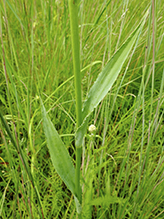 |
|
Views of the Rachel C. Lilly Preserve, Dodge Nature Center. A variety of plants and flowers, including a large patch of rattlesnake master found in the northeastern part of the property. |
||
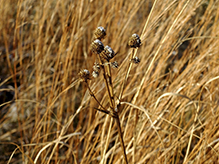 |
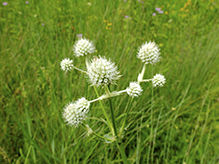 |
|
Robert Briggs |
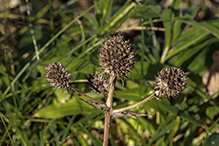 |
Fruit |
MinnesotaSeasons.com Photos |
||
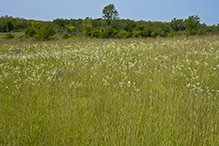 |
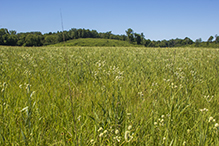 |
|
Habitat |
Habitat |
|
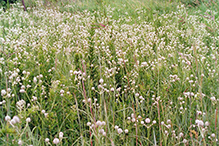 |
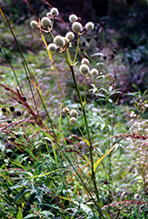 |
|
Habitat |
||
|
||
|
||
|
Plant |
|
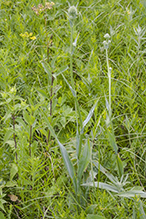 |
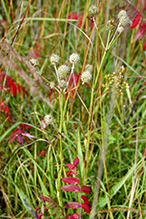 |
|
Plant |
Plant |
|
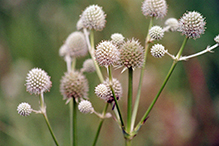 |
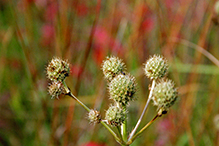 |
|
Inflorescence |
Inflorescence |
|
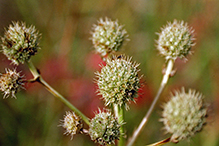 |
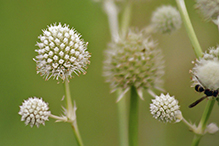 |
|
Inflorescence |
Flower head |
|
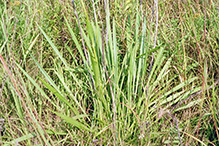 |
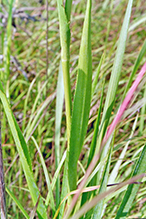 |
|
Leaves |
||
|
||
|
||
|
Leaves |

Visitor Videos |
||
Share your video of this plant. |
||
This button not working for you? |
||
|
Other Videos |
||
Rattlesnake Master - Eryngium yuccifolium as companion plant at Ion Exchange |
About
Uploaded on Aug 7, 2011 Earthyman views Rattlesnake Master (Eryngium yuccifolium) in bloom in companion perennial planting at Ion Exchange native seed and plant nursery in northeast Iowa. http://www.ionxchange.com |
Rattlesnake Master, Eryngium yuccifolium (part 1) |
About
Uploaded on Jul 18, 2010 Not what I would call a "good" nectar plant, but the pollinators that visit it are almost unique to the plant. A Mud Dauber and a Scoliid Wasp are featured in the video. This is what four plants on their first year from the nursery look like. I read the can get much larger and have even more flowers on them. |
Rattlesnake Master, Eryngium yuccifolium (part 2) |
About
Uploaded on Jul 18, 2010 A closer look at a Scoliid Wasp. These wasps dig holes in the lawn to lay eggs in beetle grubs that eat the roots to grass plants. |
Rattlesnake Master, Eryngium yuccifolium (part 3) |
About
Uploaded on Jul 20, 2010 This plant is a Wasp magnet. Many of whom are specialized predators to grubs, spiders, and assorted other garden insects. |
Dragon fly dancing with rattlesnake master. |
About
Published on Jul 10, 2013 Grant Park Music Festival orchestra rehearsing from the Pritzker Pavilion stage while Mariani arborists prune the Lurie Garden's Shoulder Hedge. Dragon fly and rattlesnake master in foreground. |

Visitor Sightings |
||
Report a sighting of this plant. |
||
This button not working for you? |
||
Nancy Falkum |
Location: Oronoco Prairie SNA |
 |
Kirk Nelson |
Location: Dodge Nature Center A variety of plants and flowers, including a large patch of rattlesnake master found in the northeastern part of the property. |
 |
| Robert Briggs 11/3/2016 |
Location: Spring Lake Park Reserve Fruit |
 |
| Kirk Nelson 11/22/2015 |
Location: Lebanon Hills Regional Park |
 |
| Kirk Nelson 7/26/2015 |
Location: Lebanon Hills Regional Park I noticed only the one plant, but I did not do a thorough examination of the surrounding area. Another area of the park has been part of a prairie restoration (near the equestrian trailhead); maybe this plant has something to do with that. |
 |
David Ayer |
Location: Joseph A. Tauer Prairie SNA |
|
MinnesotaSeasons.com Sightings |
||

|
Created: 10/7/2005 Last Updated: © MinnesotaSeasons.com. All rights reserved. |
